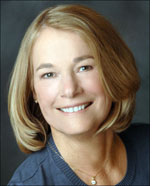Samuel’s Daughter by Ann Brener, BookSurge Publishing, 2010, 230 pages, ISBN: 1439249911, paperback, $14.95
By Laurel Corona

SAN DIEGO–In the spirit of Anita Diamant’s The Red Tent, Ann Bremer takes three individuals mentioned briefly in the Babylonian Talmud and fleshes them out into a rewarding story about life in the Jewish Diaspora in the third-century CE.
The prologue of Bremer’s novel, Samuel’s Daughter, is set in Nehardea, a Jewish town situated along the banks of the Euphrates River. Under the Persian general Odenathus, Nehardea is sacked and a little girl, orphaned as a result of the soldier’s murder of her mother, is carried off by a Parthian soldier who is fighting in the Persian army.
A few years pass, and the little girl, Rachel, is now growing up as part of a Zoroastrian family in the Gurgan Valley region of the Parthian Empire. Her memory of her past is hazy, except for a verse, whose meaning she does not know, that is part of her favorite game, Shabbat. “Barukhatahadonai eloheinumelechhaolam,” she teaches Shirin, whom she thinks of as her older sister, as they recreate the Shabbat meal in a manner akin to playing house.
Rachel looks different from the other children in her family, but she is deeply loved, especially by Issur, her older “brother.” Still, something isn’t right in her heart, and she wonders whether this might be connected to her upheaval from her original home. When she is eventually “found,” however, by traders from her homeland, she returns to Nehardea, only to end up feeling equally out of place there.
As the long-lost daughter of Samuel, a revered rabbi of blessed memory, her place in the community would seem to be assured, although her reappearance also causes great disruption. The story grows more complicated as she reaches marriageable age and her heart is torn between Issur and the son of a local rabbi, whom she discovers she was betrothed to before she was even born.
Bremer gives her novel the secondary title of “A Love Story from Third-Century Parthia,” so the reader never fears that all will work out well in the end. Since the book opens with passages from the Talmud that tell the story, it will not be a plot spoiler to reveal that the book ends with Rachel in a tender and affectionate marriage, pregnant with Mari, whom the Talmud indicates was a distinguished rabbi just like his grandfather Samuel.
Between the horrifying opening of the novel and its happy ending lies a story of much charm and sweetness. The reader will sympathize with Rachel’s confusion and longing to fit in, cheer her plucky, independent spirit, and wish her much happiness.
As a historical novelist myself, I know how hard it is to write about cultures that are remote in time and culture from our own, and so it shouldn’t be a surprise that the settings and details in the Gurgan Valley chapters seem a bit generic. Brener, the Hebraic Area Specialist at the Library of Congress and author of two non-fiction books about medieval Hebrew poets, is on presumably less familiar territory when she is writing about Zoroastrian culture in a part of the world that is largely unfamiliar to most of us in the west, than when she moves the story back to Nehardea.
The book really takes off after Rachel’s return there. The Jewish matrons of Nehardea are a delight. Their schemes and power ploys are narrated with a wry and loving sense of humor, and the details of Jewish life are vivid. Although the emotional dimensions of the story tend to be underplayed (Brener rather inexplicably treats Rachel’s departure from the only family she had ever known as hardly wrenching at all), the book remains lively and interesting.
Samuel’s Daughter appears to have been written for adult readers, but its length, readability, and discreet treatment of romance and violence would make it a highly suitable book for younger readers.
*
Corona is a professor of humanities at San Diego City College, an author and freelance writer